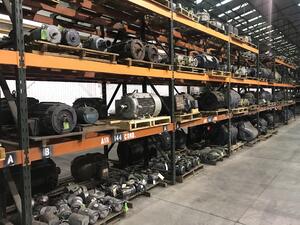Proper Storage Practices for Spare Electric Motors - HECO
April 18, 2018
Many companies have spare electric motors in their warehouse in the event of a critical motor failure. Many times this can be an intelligent decision, allowing for quick change out in the event of a failure (or pending failure) or during a scheduled outage or shutdown.
It is important to have a plan for when a critical asset goes down. What is even more important is to not have a false sense of security in your spare assets, assuming they are ready to go when they actually are not.
Time after time, we go into facilities and see motors stored in terrible environments and never maintained. This creates the image of preparedness but in reality there is no plan. What is the point of having an spare that isn’t usable when it’s time comes?
Here’s an example: The in-service motor fails, you spend the time and resources to pull it out, then you mount the “spare” motor in it’s place. The spare has been in your non heated warehouse, on the shelf for about 7 years, with the shaft never rotated and never checked electrically. You install it and that motor runs for about 5 hours and then you hear a bearing noise. Now your original motor is at a repair facility being inspected but becomes rush because your spare has an immediate failure. You are now paying rush for a repair and you have no spare. All long, you thought you were prepared but in reality you were not.
A few simple practices could have helped to prevent this issue. Below are some standard recommended practices for storing spare electric motors:
- Understand if the motor on your shelf was in repaired, used, or new status.
- Keep a record of repair history and reports for comparison when the motor goes into service, hopefully years down the road.
- Spin shafts regulatory (at least quarterly)
- Turn on the motor’s heaters if not in a temperature controlled warehouse.
- Perform an insulation resistance to ground (Megger and or polarization index) test regularly (twice a year) on each motor and trend the results.
- Evaluate the need for rodent control practices in the warehouse
- Keep spares in clean environment, preventing contamination exposure.
- Keep spares away from water or moisture
There are a variety of other recommended practices. To verify exactly what you should do, especially to maintain your motor’s warranty, check with the manufacturer of the motor or your trusted motor repair provider.
Posted in Equipment Management
